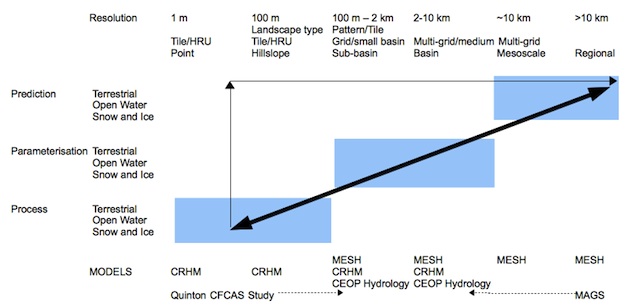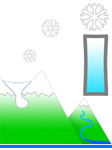Processes
Parameterisation
Prediction |
Theme 2 - Parameterisation
The objective of Theme 2 is to improve the basin-scale
parameterisations of cold regions processes for small to medium
scale modelling.
Theme 2 Participants
Name |
Affiliation |
| Sean Carey |
Carleton University |
| Richard Essery |
University of Edinburgh, UK |
| Raoul Granger |
Environment Canada |
| Masaki Hayashi |
University of Calgary |
| Murray Mackay |
Environment Canada |
| Philip Marsh |
University of Saskatchewan |
| Scott Munro |
University of Toronto |
| John Pomeroy |
University of Saskatchewan |
| William Quinton (Theme Leader) |
Wilfrid Laurier University |
| Ken Snelgrove |
Memorial University of
Newfoundland |
| Ric Soulis |
University of Waterloo |
| Chris Spence |
University of Saskatchewan |
| Diana Verseghy |
University of Waterloo |
Process Parameterisation
The parameterisation strategy involves explicit recognition
of the strong spatial heterogeneity of land surface hydrology
processes with a hierarchy based on tiles (as small as
hillslopes or landscape units), then sub-basins, and then
aggregations of basins. This IP3 strategy recognizes the drainage
basin as a basic land surface parameterisation unit and allows
for testing of the transferability of parameterisations
developed at point scales to small basin and larger scales.
Processes are described up to the tile with accommodation for
sub-tile variability. Tiles are aggregated according to observed
interactions in the research basins. In some basins there are
important horizontal interactions between tiles with water and
snow moving horizontally from one tile to the next, while others can be considered to have tiles that only generate
streamflow and vertical fluxes of radiation, water vapour, and
sensible heat. These differences in landscape behaviour have
great implications for the aggregation strategy employed in
basin parameterisations.

Theme 2 Schedule, Milestones, and Deliverables
Year 1:
- Setup CRHM at selected test basins representing each of the 4
regions (i.e. arctic, alpine, wetland, shield) in HRU and then
GRU mode
- Assess existing parameterizations against archives of
mass and energy balances over complex terrain
- Initial development of improved parameterizations
including advection
- Coordinate with the WC2N (CFCAS Network) group to
acquire data set for testing mass and energy balance models
over glaciated terrain
- Assessment of MAGS aircraft for use in determining regionally
averaged fluxes
Year 2:
- Performance evaluation of CRHM in both GRU and HRU
routing/aggregation modes against field and distributed
modelling data
- Evaluate MESH performance with reference to measured mass and
energy balances, CRHM and distributed modelling data
- Characterize surface parameter distributions
- Develop improved snow, melt, subsurface flow, radiation and
turbulent flux parameterizations
Year 3:
- Incorporate numerical representations of snow redistribution,
advection, lakes, landscape and water course connectivity, into CRHM and MESH
- Develop up-scaled mass and energy balance equations for
cryospheric processes in complex vegetated terrain
- representation of regionally averaged fluxes over lake and
snow dominated terrain
Year 4:
- Test and evaluate CRHM and MESH (CLASS) with new
algorithms, and compare model outputs to observations,
distributed models and output of previous version. Revise
code
- Compare CRCM runs to observations, revise CLASS code as
necessary
- Implement parameterizations in coupled models
|






